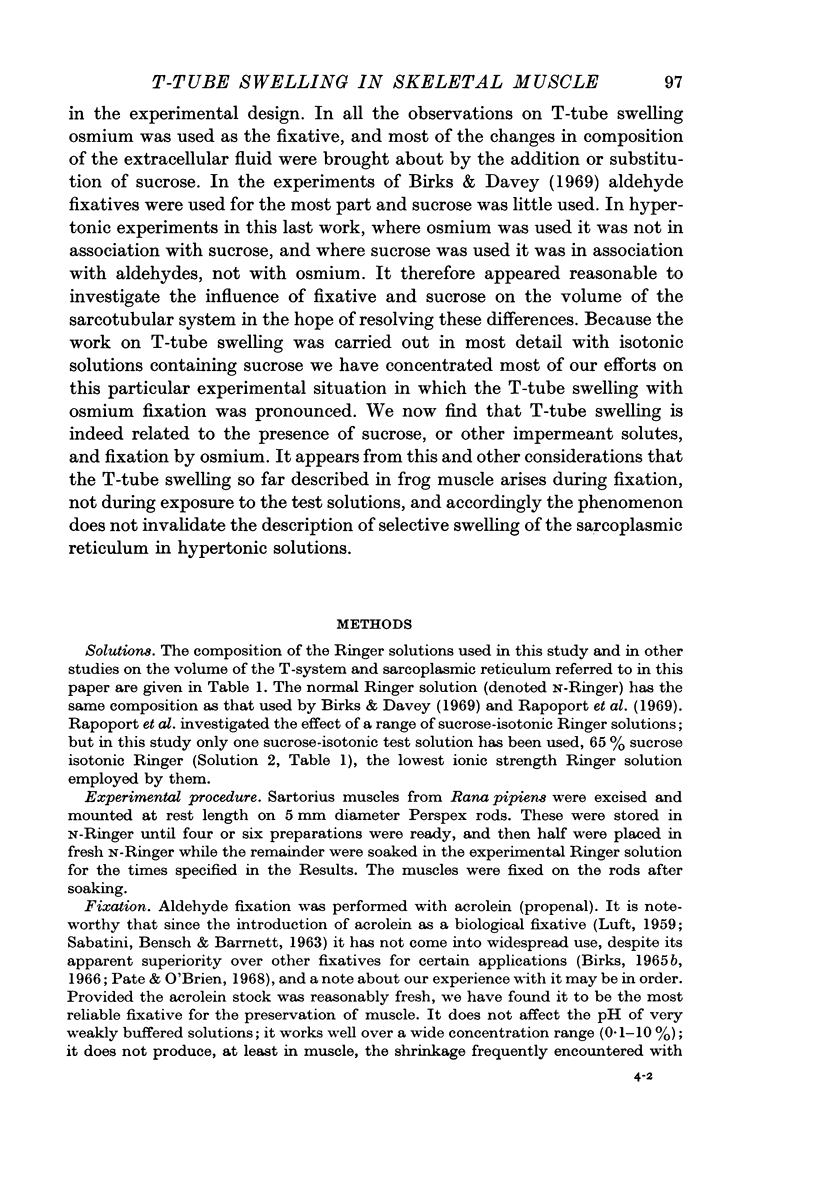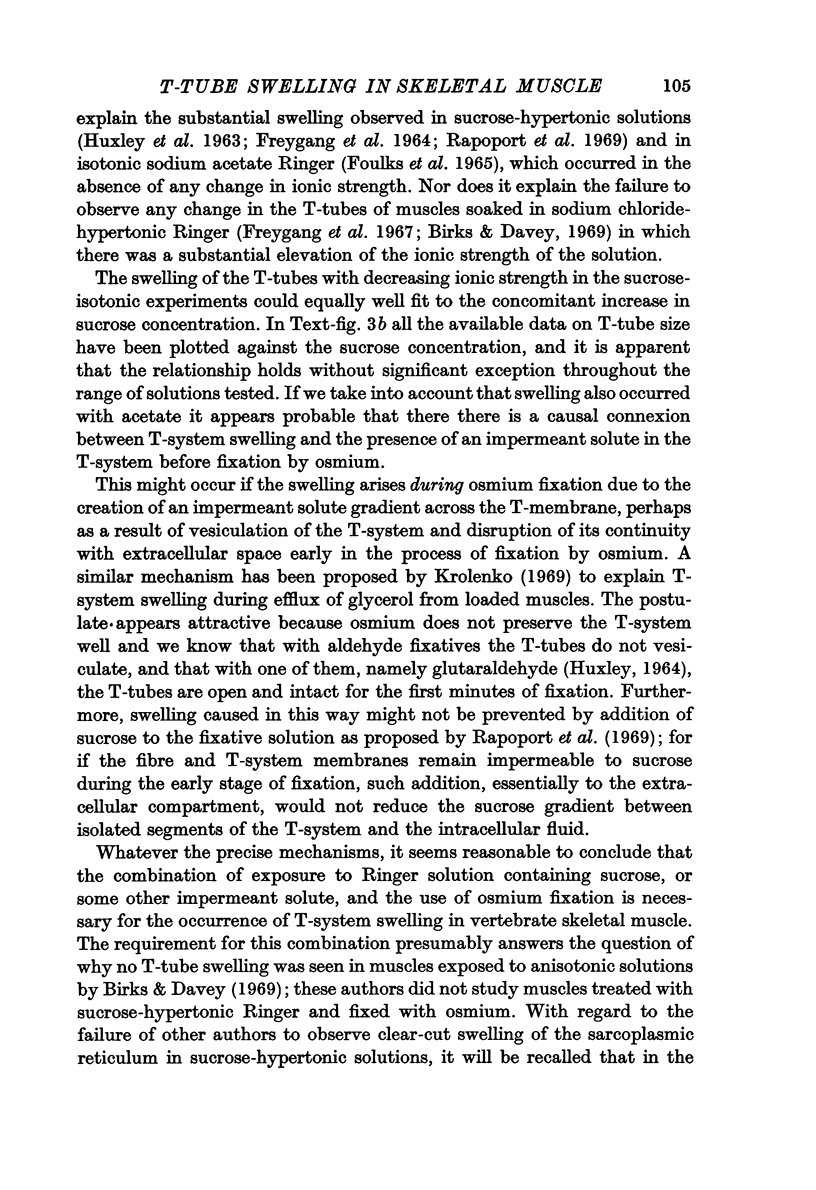Abstract
The volume responses of the T-system of frog skeletal muscle to isotonic solutions of altered ionic composition, as studied by electron microscopic examination of osmium-fixed tissue, have been re-investigated using aldehyde fixatives.
1. In confirmation of the earlier work we find that the T-tubes swell in frog sartorius muscles which have been soaked in Ringer solution in which the sodium chloride concentration has been reduced to 40 mM and tonicity maintained with sucrose before fixation in osmium.
2. The swelling does not occur in muscles similarly treated, but fixed with acrolein or glutaraldehyde.
3. Swelling of the T-tubes, which has been reported for osmium-fixed muscle following exposure to Ringer in which chloride is replaced by acetate, or reduced and sulphate substituted, does not occur when fixation is by acrolein.
4. Analysis of the data from the earlier work with sucrose substitution shows that the degree of T-tube swelling is proportional to the sucrose concentration of the soaking medium, whether the solution be isotonic or anisotonic.
5. It is concluded that the increase in T-tube volume arises in muscles which have been exposed to certain impermeant solutes during fixation by osmium, and a possible mechanism to account for the effect is described.
6. The relevance of these observations to the hypothesis that the sarcoplasmic reticulum is an extracellular compartment in muscle and to the proposal that the T-tubes may represent an intermediate compartment for potassium fluxes is discussed.
Full text
PDF


















Images in this article
Selected References
These references are in PubMed. This may not be the complete list of references from this article.
- ADRIAN R. H., FREYGANG W. H. Potassium conductance of frog muscle membrane under controlled voltage. J Physiol. 1962 Aug;163:104–114. doi: 10.1113/jphysiol.1962.sp006960. [DOI] [PMC free article] [PubMed] [Google Scholar]
- Adrian R. H., Freygang W. H. The potassium and chloride conductance of frog muscle membrane. J Physiol. 1962 Aug;163(1):61–103. doi: 10.1113/jphysiol.1962.sp006959. [DOI] [PMC free article] [PubMed] [Google Scholar]
- Birks R. I., Davey D. F. Osmotic responses demonstrating the extracellular character of the sarcoplasmic reticulum. J Physiol. 1969 May;202(1):171–188. doi: 10.1113/jphysiol.1969.sp008802. [DOI] [PMC free article] [PubMed] [Google Scholar]
- Birks R. I. The fine structure of motor nerve endings at frog myoneural junctions. Ann N Y Acad Sci. 1966 Jan 26;135(1):8–19. doi: 10.1111/j.1749-6632.1966.tb45458.x. [DOI] [PubMed] [Google Scholar]
- Bone Q., Denton E. J. The osmotic effects of electron microscope fixatives. J Cell Biol. 1971 Jun;49(3):571–581. doi: 10.1083/jcb.49.3.571. [DOI] [PMC free article] [PubMed] [Google Scholar]
- Brandt P. W., Reuben J. P., Grundfest H. Correlated morphological and physiological studies on isolated single muscle fibers. II. The properties of the crayfish transverse tubular system: localization of the sites of reversible swelling. J Cell Biol. 1968 Jul;38(1):115–129. doi: 10.1083/jcb.38.1.115. [DOI] [PMC free article] [PubMed] [Google Scholar]
- DYDYNSKA M., WILKIE D. R. THE OSMOTIC PROPERTIES OF STRIATED MUSCLE FIBERS IN HYPERTONIC SOLUTIONS. J Physiol. 1963 Nov;169:312–329. doi: 10.1113/jphysiol.1963.sp007258. [DOI] [PMC free article] [PubMed] [Google Scholar]
- DYDYNSKA M., WILKIE D. R. THE OSMOTIC PROPERTIES OF STRIATED MUSCLE FIBERS IN HYPERTONIC SOLUTIONS. J Physiol. 1963 Nov;169:312–329. doi: 10.1113/jphysiol.1963.sp007258. [DOI] [PMC free article] [PubMed] [Google Scholar]
- Ezerman E. B., Ishikawa H. Differentiation of the sarcoplasmic reticulum and T system in developing chick skeletal muscle in vitro. J Cell Biol. 1967 Nov 1;35(2):405–420. doi: 10.1083/jcb.35.2.405. [DOI] [PMC free article] [PubMed] [Google Scholar]
- FREYGANG W. H., Jr, GOLDSTEIN D. A., HELLAM D. C., PEACHEY L. D. THE RELATION BETWEEN THE LATE AFTER-POTENTIAL AND THE SIZE OF THE TRANSVERSE TUBULAR SYSTEM OF FROG MUSCLE. J Gen Physiol. 1964 Nov;48:235–263. doi: 10.1085/jgp.48.2.235. [DOI] [PMC free article] [PubMed] [Google Scholar]
- Foulks J. G., Pacey J. A., Perry F. A. Contractures and swelling of the transverse tubules during chloride withdrawal in frog skeletal muscle. J Physiol. 1965 Sep;180(1):96–115. [PMC free article] [PubMed] [Google Scholar]
- Freygang W. H., Jr, Rapoport S. I., Peachey L. D. Some relations between changes in the linear electrical properties of striated muscle fibers and changes in ultrastructure. J Gen Physiol. 1967 Nov;50(10):2437–2458. doi: 10.1085/jgp.50.10.2437. [DOI] [PMC free article] [PubMed] [Google Scholar]
- Good N. E., Winget G. D., Winter W., Connolly T. N., Izawa S., Singh R. M. Hydrogen ion buffers for biological research. Biochemistry. 1966 Feb;5(2):467–477. doi: 10.1021/bi00866a011. [DOI] [PubMed] [Google Scholar]
- HARRIS E. J. Distribution and movement of muscle chloride. J Physiol. 1963 Apr;166:87–109. doi: 10.1113/jphysiol.1963.sp007092. [DOI] [PMC free article] [PubMed] [Google Scholar]
- HODGKIN A. L., HOROWICZ P. The effect of sudden changes in ionic concentrations on the membrane potential of single muscle fibres. J Physiol. 1960 Sep;153:370–385. doi: 10.1113/jphysiol.1960.sp006540. [DOI] [PMC free article] [PubMed] [Google Scholar]
- HUXLEY H. E. EVIDENCE FOR CONTINUITY BETWEEN THE CENTRAL ELEMENTS OF THE TRIADS AND EXTRACELLULAR SPACE IN FROG SARTORIUS MUSCLE. Nature. 1964 Jun 13;202:1067–1071. doi: 10.1038/2021067b0. [DOI] [PubMed] [Google Scholar]
- KELLENBERGER E., RYTER A., SECHAUD J. Electron microscope study of DNA-containing plasms. II. Vegetative and mature phage DNA as compared with normal bacterial nucleoids in different physiological states. J Biophys Biochem Cytol. 1958 Nov 25;4(6):671–678. doi: 10.1083/jcb.4.6.671. [DOI] [PMC free article] [PubMed] [Google Scholar]
- Kelly A. M. Sarcoplasmic reticulum and T tubules in differentiating rat skeletal muscle. J Cell Biol. 1971 May 1;49(2):335–344. doi: 10.1083/jcb.49.2.335. [DOI] [PMC free article] [PubMed] [Google Scholar]
- Krolenko S. A. Changes in the T-system of muscle fibres under the influence of influx and efflux of glycerol. Nature. 1969 Mar 8;221(5184):966–968. doi: 10.1038/221966a0. [DOI] [PubMed] [Google Scholar]
- LUFT J. H. Improvements in epoxy resin embedding methods. J Biophys Biochem Cytol. 1961 Feb;9:409–414. doi: 10.1083/jcb.9.2.409. [DOI] [PMC free article] [PubMed] [Google Scholar]
- PAGE E. Cat heart muscle in vitro. III. The extracellular space. J Gen Physiol. 1962 Nov;46:201–213. doi: 10.1085/jgp.46.2.201. [DOI] [PMC free article] [PubMed] [Google Scholar]
- PALADE G. E. A study of fixation for electron microscopy. J Exp Med. 1952 Mar;95(3):285–298. doi: 10.1084/jem.95.3.285. [DOI] [PMC free article] [PubMed] [Google Scholar]
- PEACHEY L. D. Thin sections. I. A study of section thickness and physical distortion produced during microtomy. J Biophys Biochem Cytol. 1958 May 25;4(3):233–242. doi: 10.1083/jcb.4.3.233. [DOI] [PMC free article] [PubMed] [Google Scholar]
- Peachey L. D. The sarcoplasmic reticulum and transverse tubules of the frog's sartorius. J Cell Biol. 1965 Jun;25(3 Suppl):209–231. doi: 10.1083/jcb.25.3.209. [DOI] [PubMed] [Google Scholar]
- REYNOLDS E. S. The use of lead citrate at high pH as an electron-opaque stain in electron microscopy. J Cell Biol. 1963 Apr;17:208–212. doi: 10.1083/jcb.17.1.208. [DOI] [PMC free article] [PubMed] [Google Scholar]
- Rapoport S. I. A fixed charge model of the transverse tubular system of frog sartorius. J Gen Physiol. 1969 Aug;54(2):178–187. doi: 10.1085/jgp.54.2.178. [DOI] [PMC free article] [PubMed] [Google Scholar]
- Rapoport S. I., Peachey L. D., Goldstein D. A. Swelling of the transverse tubular system in frog sartorius. J Gen Physiol. 1969 Aug;54(2):166–177. doi: 10.1085/jgp.54.2.166. [DOI] [PMC free article] [PubMed] [Google Scholar]
- SABATINI D. D., BENSCH K., BARRNETT R. J. Cytochemistry and electron microscopy. The preservation of cellular ultrastructure and enzymatic activity by aldehyde fixation. J Cell Biol. 1963 Apr;17:19–58. doi: 10.1083/jcb.17.1.19. [DOI] [PMC free article] [PubMed] [Google Scholar]
- SIMON S. E., SHAW F. H., BENNETT S., MULLER M. The relationship between sodium, potassium, and chloride in amphibian muscle. J Gen Physiol. 1957 May 20;40(5):753–777. doi: 10.1085/jgp.40.5.753. [DOI] [PMC free article] [PubMed] [Google Scholar]
- STEINBACH H. B. Intracellular inorganic ions and muscle action. Ann N Y Acad Sci. 1947 May 30;47(ART):849–874. doi: 10.1111/j.1749-6632.1947.tb31740.x. [DOI] [PubMed] [Google Scholar]
- Sandow A. Skeletal muscle. Annu Rev Physiol. 1970;32:87–138. doi: 10.1146/annurev.ph.32.030170.000511. [DOI] [PubMed] [Google Scholar]
- Spurr A. R. A low-viscosity epoxy resin embedding medium for electron microscopy. J Ultrastruct Res. 1969 Jan;26(1):31–43. doi: 10.1016/s0022-5320(69)90033-1. [DOI] [PubMed] [Google Scholar]
- Vinogradova N. A. Raspredelenie inulina, sakharozy i fruktozy v portniazhnykh myshtsakh liagushki. Tsitologiia. 1967 Jul;9(7):781–790. [PubMed] [Google Scholar]
- Vinogradova N. A. Raspredelenie nepronikaiushchikh sakharov v portniazhnykh myshtsakh liagushki v usloviiakh giopo- i gipertonii. Tsitologiia. 1968 Jul;10(7):831–838. [PubMed] [Google Scholar]
- WATSON M. L. The use of carbon films to support tissue sections for electron microscopy. J Biophys Biochem Cytol. 1955 Mar;1(2):183–184. doi: 10.1083/jcb.1.2.183. [DOI] [PMC free article] [PubMed] [Google Scholar]








